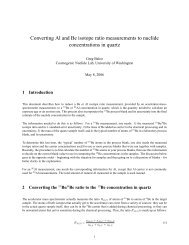Be exposure age calculator MATLAB function reference Version 2
Be exposure age calculator MATLAB function reference Version 2
Be exposure age calculator MATLAB function reference Version 2
You also want an ePaper? Increase the reach of your titles
YUMPU automatically turns print PDFs into web optimized ePapers that Google loves.
The objective <strong>function</strong> involves several numerical integrations, so finding its zero can be slow. The easiest way to<br />
speed it up is to provide it with an initial guess for the solution that is close to the actual solution. We do this by first<br />
estimating the erosion rate using the simple equation of Lal (1991), which disregards production by muons:<br />
P<br />
N =<br />
λ +<br />
ɛ<br />
(21)<br />
Λ sp<br />
Here we calculate P using the non-time-dependent St scaling scheme.<br />
This can be solved directly for ɛ to obtain the initial guess.<br />
3. Calculate the production rates; pass to objective <strong>function</strong>; solve.<br />
We then assemble the <strong>function</strong>s P sp,0 (t) (for each scaling scheme) and P µ (z) and pass them to the objective <strong>function</strong>,<br />
then find its zero to obtain the corresponding erosion rate for each scaling scheme.<br />
The actual assembly of P sp,0 (t) for the four time-dependent scaling schemes is the same as is used in get_al_be_<strong>age</strong>.m,<br />
and is described above in section 1.3.<br />
P µ (z) is generated on a 100-point log-spaced vector from 0 to 2 × 10 5 g · cm −2 using the <strong>function</strong> P_mu_total.m.<br />
The spacing of this vector affects the accuracy of the solution; this is discussed in more detail in the documentation<br />
for ET_objective.m.<br />
4. Error propagation.<br />
The fact that the full erosion rate equation cannot be solved analytically also makes error propagation difficult. We<br />
propagate errors linearly via the standard error propagation formula, but we cannot compute the derivatives of the<br />
derived erosion rate with respect to the uncertain input parameters, that are required in the formula, analytically, so<br />
two additional solutions of the full equation are required to estimate the partial derivative with respect to each uncertain<br />
parameter. It is time-consuming to do this using the full forward model, so we use a simplified erosion rate - nuclide<br />
concentration relationship for the uncertainty analysis:<br />
P eff,sp<br />
ɛ +<br />
Λ sp<br />
λ i +<br />
λ i +<br />
P µ<br />
ɛ − N m = 0 (22)<br />
Λ µ,eff<br />
where λ is the decay constant for the nuclide of interest, P eff,sp is the effective surface production rate due to spallation,<br />
P µ is the surface production rate due to muons, Λ sp is the effective attenuation length for production by spallation,<br />
and Λ µ,eff is the effective attenuation length for production by muons. Both Λ µ,eff and P eff,sp depend on the erosion<br />
rate, which is why this simplified equation cannot be used to accurately calculate the erosion rate in the first<br />
place. However, as we have already calculated N µ , the nuclide concentration attributable to production by muons, in<br />
the course of solving the full equation above, we can calculate the value of Λ µ,eff for which the simplified equation<br />
would yield the true erosion rate by:<br />
Λ µ,eff =<br />
ɛ true<br />
P µ<br />
N µ<br />
− λ<br />
(23)<br />
where ɛ true is the ‘true’ erosion rate calculated by solving the full equation.<br />
16



